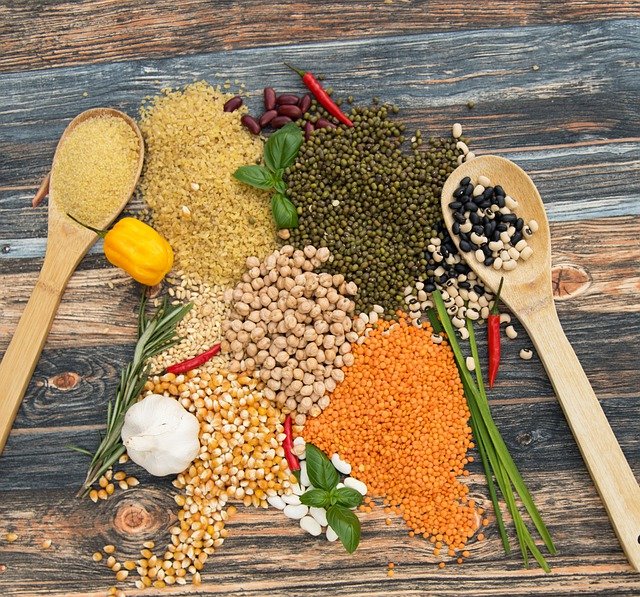
Rich in nutritional properties, legumes must be routinely introduced into our diet. Let’s see why they are so important for health and how to eat them regularly.
Legumes are the edible seeds of plants belonging to the Fabaceae or Leguminosae family. Eating legumes regularly is very important, thanks to their countless nutritional qualities. They are an excellent source of vegetable protein, particularly when associated with cereals. Cereals, in fact, are rich in 2 amino acids, cystine and methionine, which are lacking in legumes.
Legumes are low in fat and high in fiber, so they are excellent for those who follow a balanced diet. The fibers contained in them increase the sense of satiety, stimulate intestinal transit, decrease the incidence of colorectal cancer and limit the absorption of fats and sugars, decreasing the values of glucose and cholesterol in the blood.
Legumes provide many vitamins, in particular those of group B, essential for energy metabolism, and many minerals such as iron, calcium and zinc. There are therefore numerous benefits deriving from the consumption of legumes, as they prevent cancer but also cardiovascular diseases, are suitable for diabetics thanks to their low glycemic index and can be safely consumed by celiacs as they are naturally gluten-free.
The consumption of legumes lowers blood pressure, prevents type 2 diabetes and allows for good control of body weight.
Essential food for our health, legumes should be eaten at least 2-3 times a week. They are also very versatile in cooking, as they can be eaten in the form of soups in cold seasons and as salads in warm seasons. There are also legume flours, with which to prepare biscuits and savory pies, but also pastas made with legume flours. Let’s see how to include legumes in the diet.
10 tips for including legumes in your diet
Many people complain of abdominal swelling after the consumption of legumes, this occurs due to the fermentation of the oligosaccharides present in legumes by our intestinal bacterial flora. To avoid this annoying problem, the best thing to do is to accustom the intestine and therefore “educate” it to the regular consumption of legumes. Another fundamental thing is adequate preparation, with small precautions to follow. Here are some tips for introducing legumes into your diet.
1. Which legumes to eat to start
To avoid digestive difficulties and annoying abdominal bloating, it is necessary to gradually introduce legumes in the diet and start with the most easily digestible ones. Several studies show that flatulence due to the consumption of legumes decreases over time with the continued consumption of legumes, with some exceptions.
The important thing is to introduce them in small quantities, starting with a tablespoon a day, and gradually increase to the ideal portion for your physical condition. An average portion is about 50 grams for dried legumes and 150 grams for fresh ones.
To start, it is always better to consume fresh legumes, more easily digestible, and then move on to shelled legumes, which are deprived of the external cuticle and are therefore digested more easily than dry ones and create less abdominal swelling. Once the fresh and shelled legumes have been introduced, it is possible to move on to more digestible dried legumes, such as mung beans and azuki beans, and then introduce the dried lentils and cannellini beans and, finally, chickpeas and borlotti beans, which are the ones that they are digested with more difficulty, always starting from small quantities.
2. The advantages of shelled legumes
The shelled legumes are nothing more than legumes without the peel. They are used for babies during weaning, precisely because they are more delicate and easier to digest. They can be taken by those who have difficulty digesting dried legumes, but also by those suffering from irritable colon, as they are deprived of the external fiber that can irritate the intestinal walls. In addition, shelled legumes cook in much less time than legumes with the peel, and this is an advantage for those who have little time available. On the market, peeled lentils are more easily found, which have a characteristic orange color, but there are also chickpeas, peas, cicerchieand shelled beans, although more difficult to find.
3. If you are short on time, choose legumes in glass
The best way to consume legumes is certainly to prepare them yourself, after the right soaking times and adequate cooking. But if you don’t have the time, this shouldn’t be an excuse not to eat them. There are, in fact, legumes already boiled, sold in tin and glass packs. For a healthier choice, it is advisable to consume legumes in glass as glass is an inert material while tin could release substances to legumes that come into contact with it, especially if salt is present. However, it is important to rinse the legumes very wellfrom the liquid in which they are immersed. Furthermore, the choice of glass allows us to protect the environment as the jars can be reused at home as containers. Finally, try to choose legumes from organic crops, free of pesticides, and read the labels carefully, in order to make sure that only legumes, water and, at the most, salt appear among the ingredients.
4. The importance of soaking for dried legumes
Dried legumes need to be soaked before cooking. This operation is necessary to return the water to the legumes, to make them softer and therefore more digestible, but also and above all to eliminate some anti-nutrient substances present in legumes such as phytic acid, which reduces the absorption of mineral substances, and antidigestive substances.
First of all it is necessary to wash the dried legumes under running water on a colander and remove any fragments. Then you have to put the legumes in a large bowl, as after soaking they will triple their volume. Generally lentils and peas, even if dry, do not need to be soaked because they are small in size, but a couple of hours helps to make them more digestible. For other legumes such as chickpeas, broad beans and beans, soaking takes about 12 hours, the ideal is to let them soak overnight and cook them the next day.
Another thing to do, if possible, is to change the soaking water, even once or twice is enough. The soaking water is then thrown away and the legumes rinsed. Some use a pinch of bicarbonate in the soaking water of chickpeas and beans, to make the peel softer, in reality this addition modifies the nutritional value of legumes, in particular by decreasing a part of the vitamin B1 present and making it difficult to assimilate the beans. amino acids.
5. How to cook legumes without making mistakes
The next fundamental step is proper cooking. For fresh legumes it will be enough from half an hour to an hour of cooking, using double the water compared to the weight of the legumes. For shelled legumes, times vary and range from 10 to 20 minutes. For dried legumes, it is important to add three times the water compared to the weight of legumes as they will grow a lot during cooking. Cooking times are variable, and usually range from 2 to 3 hours. Cooking must take place over low heat and with the lid slightly open.
6. Pots for cooking legumes
The ideal pots for cooking legumes are the pressure cooker and earthenware pots. Aluminum or non-stick pans tend to hinder cooking and cause the color of the legumes to vary. The pressure cooker allows you to halve cooking times and keep the nutritional properties more intact, allowing you to gain in time and health. The earthenware pots heat up slowly and just as slowly transfer the heat to the legumes, allowing slow and uniform cooking. In this case, the legumes retain a better flavor and are more digestible. For those lucky enough to have a fireplace, legumes can be cooked in what is called a “pignata”, a longer earthenware pot that is placed next to the embers and left there for many hours, making the legumes much more digestible and tasty.
7. When to add salt? And the oil?
Salt must be added when cooked, otherwise the skin of the legumes becomes hard. The use of a good whole sea salt is recommended, which further enhances the flavor. Oil is also best added at the end, to preserve its nutritional properties. The best oil to use is extra virgin olive oil, rich in antioxidant and protective substances against cardiovascular and cancer diseases. 8How to make them more digestible There are some tricks to make legumes more digestible . Among these, the addition of a piece of kombu seaweed (about one cm) during cooking will certainly help to counteract the formation of abdominal gas. In addition, aromatic herbs and ingredients that stimulate gastric secretions such as chilli, celery, rosemary, oregano and bay leaf can be added during cooking. Cumin and fennel seeds can also be added for their carminative power. But the key thing to not have digestive problems and flatulence is certainly to chew very slowly. In fact, legumes are rich in carbohydrates, whose digestion begins in the mouth thanks to digestive enzymes present in saliva. It is therefore important to chew each bite very carefully, without being in a hurry.
9. What to eat together with legumes?
The best combination to do is certainly to eat legumes with cereals, as both compensate for the lack of some amino acids, resulting in a complete food from a nutritional point of view. The ideal is to consume whole grains, to increase the amount of fiber in the meal. Since legumes are rich in proteins, it is better not to combine them with other protein sources such as meats, cheeses and eggs, also because they would increase digestion times. When you consume legumes, start your meal with a plate of raw salad, it will help your digestion the most.
10. Herbal tea to facilitate digestion
If despite all these precautions, you struggle to digest legumes and feel bloated after eating them, you can consume an herbal tea based on digestive and carminative seeds such as fennel and anise. To prepare it, it will be necessary to boil 200 ml of water with a teaspoon of fennel seeds and a teaspoon of aniseed for 10 minutes, then turn off the heat, let it rest for 5 minutes, filter and drink. To enhance the digestive action of the herbal tea, the last 5 minutes you can add 2-3 leaves of fresh mint.






